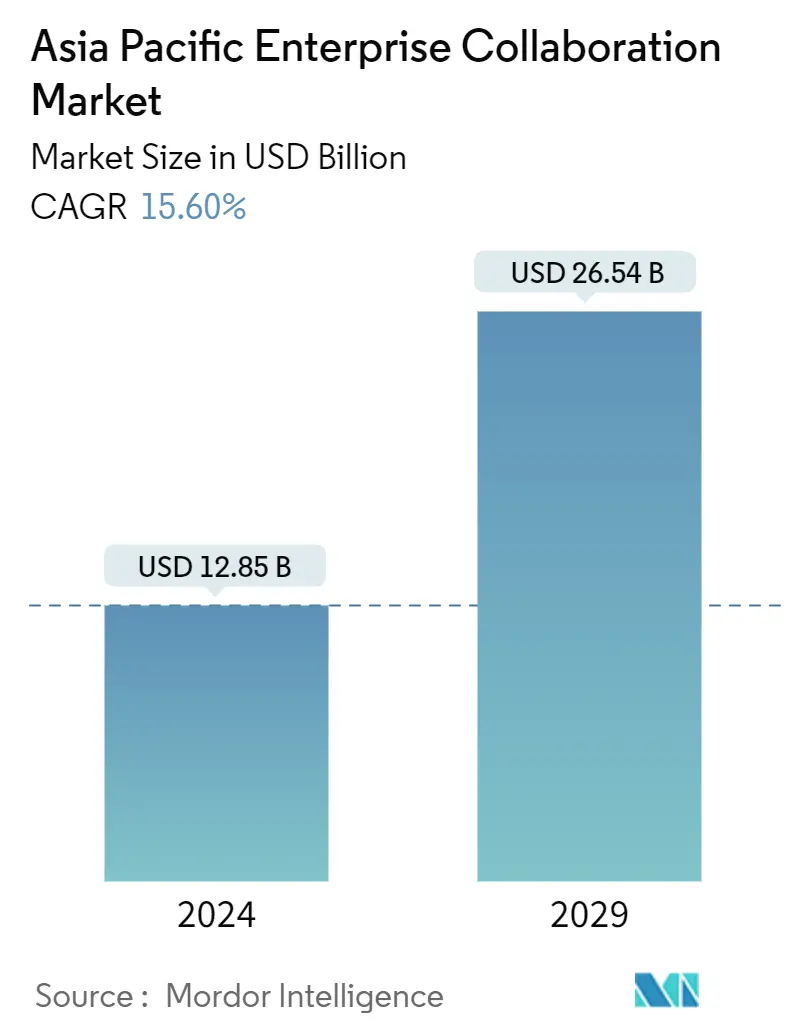Market Size of Asia Pacific Enterprise Collaboration Industry

| Study Period | 2019 - 2029 |
| Base Year For Estimation | 2023 |
| Market Size (2024) | USD 12.85 Billion |
| Market Size (2029) | USD 26.54 Billion |
| CAGR (2024 - 2029) | 15.60 % |
| Market Concentration | Low |
Major Players.webp)
*Disclaimer: Major Players sorted in no particular order |
Need a report that reflects how COVID-19 has impacted this market and its growth?
Asia Pacific Enterprise Collaboration Market Analysis
The Asia Pacific Enterprise Collaboration Market size is estimated at USD 12.85 billion in 2024, and is expected to reach USD 26.54 billion by 2029, growing at a CAGR of 15.60% during the forecast period (2024-2029).
The growth of the market is attributed to the enterprise collaboration solutions' provision of maximum productivity, business agility, and flexibility.
- Enterprise collaboration enables employees to interact and communicate within and outside their work environment by providing access to technology that can streamline processes and encourage collaboration. Organizations are anticipated to adopt market-leading solutions as the workforce becomes more distributed, with many workers working remotely and others from conventional offices.
- With enterprise collaboration tools, staff members can easily keep track of and manage projects, encourage individual responsibility, and build stronger bonds of trust, all of which contribute to greater transparency within the workplace. The platform provides a centralized location for all communication and teamwork requirements within the organization. It boosts efficiency by eliminating redundant applications with overlapping features.
- The office demand was likely to decline during the pandemic due to corporates delaying their decisions on new offtake of commercial spaces by at least a quarter or two. As a result, significant corporates will continue to choose WFH for their business continuity. The demand for solutions that offer safer enterprise collaboration has greatly increased as a result. For instance, Due to the WFH assault, IGEL has recently experienced increased sales, providing tens of thousands of seats for its Linux OS connected to VMware, Citrix Systems, Microsoft, and Amazon. In addition, IGEL has also experienced unprecedented demand for its UD Pocket offering in Asia.
- Additionally, the rise in market revenue for enterprise collaboration is largely due to the growing use of mobile devices, and networking websites are also expected to contribute to market expansion. The main factors propelling the market are the need to combine internal and external collaboration in a single space and organizations' increased focus on fostering communication and collaboration among multiple stakeholders across different geographies.
- Furthermore, the enterprise collaboration market in this region will grow much faster because of India's rapidly expanding BFSI sector. For instance, the Niti Aayog of India reported that the Indian Finance Minister increased the FDI cap for the insurance sector in the 2021-2022 budget from 49% to 74%. As a result, the BFSI sector is anticipated to experience significant growth over the coming years.
- Technologies for enterprise collaboration are ideal for getting real-time feedback from customers, partners, stakeholders, and vendors, enabling more effective responses and improved creativity. The rapid development of technology, the rise in networking websites, and the use of mobile devices for collaboration are additional factors likely to positively affect the market's expansion.
- The companies are also focusing on cognitive collaboration, which is applying artificial intelligence to business knowledge and workflows by bringing cognitive learning and information sharing to all areas of interactions. Cognitive-powered customer interaction technologies include Natural Language Processing, Predictive Analysis, and intelligent routing.
- Throughout the forecast period, the growth of the enterprise collaboration market is anticipated to be impacted by the increase in the use of networking websites. Moreover, the main barriers to expanding enterprise collaboration are expected to be its high implementation costs and difficulty avoiding legal and discovery risks.
- The outbreak of the COVID-19 pandemic virus worldwide was anticipated to augment the demand for employees' work from home (WFH), owing to the lockdown and social distancing strategy adopted across several counties of Asia to fight the pandemic. During the COVID-19 pandemic, the demand for enterprise collaboration solutions significantly increased. Due to the need for communication among employees in various organizations, enterprise collaboration solutions increased.
